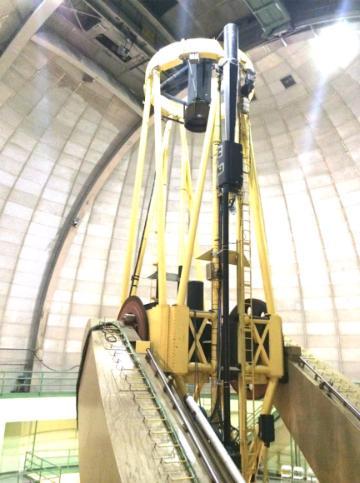
Faculty Update - Kristin Kulas
Dr. Kristin Kulas, a Lecturer in Physics at SCU since 2013, recently started a program that enables SCU physics students to work at NASA Ames on research aimed at understanding the physics of dust grain alignment with astrophysical magnetic fields. This research program, led by Dr. Kulas’s colleague Dr. B-G Andersson, allows students to use spectroscopic and photometric multi- wavelength datasets to examine and test current theories about grain alignment in magnetic fields. In addition, Dr. Kulas’s students are able to participate in observational astronomy on world-class telescopes near the SCU campus and beyond. This new program exposes select undergraduates to a complete view of astronomical research, from observation to analysis.
It is well known that dust grains in the interstellar medium (ISM) align themselves along magnetic field lines. This alignment causes the observed light from the ISM to become polarized. The polarization effect provides an important tool for probing the geometry and strength of cosmic magnetic fields. Detailed models of these fields can be carefully tested, particularly if variations in the grain alignment efficiencies can be well understood. And while quantifiable effects of astronomical grain alignment are abundantly evident, the exact physics associated with the alignment is not yet fully understood. This makes the subject area ripe for student research projects!
Recently, two SCU physics students got to work with Dr. Kulas and her NASA Ames colleagues on studies related to astrophysical grain alignment. In 2015, Sarah Youlton used near-infrared data to classify stars in the L183 cloud and determine the extinction of light passing through specific regions of the cloud. The extinction data were used to quantify the amount and size of dust grains in the cloud. During her internship, Sarah also got to participate in astronomical observations using the Shane 3- meter telescope at nearby Mount Hamilton’s Lick Observatory. She contributed to observations of the L183 cloud using the Kast instrument in the spectro-polarimeter mode to obtain additional data for future studies.
In 2016, SCU student Ilija Medan worked with the NASA team on research to carefully examine the “Local Bubble”, an area surrounding the Sun that is dominated by a low density, ionized structure. The origin of this structure is usually attributed to a combination of strong stellar winds and local supernovae. Using archival polarimetry, photometry, and spectral data, Ilija found evidence for a bimodal distribution in the magnetic field strength at the wall of the Local Bubble. This result is postulated to be due to counter-interactions at the wall; the stellar winds originating from the inside of the Local Bubble compete with effects from ongoing star formation taking place outside the Local Bubble. Ilija and colleagues plan to publish their exciting results soon in Astrophysical Journal.
Image: The Shane 3-meter telescope, commissioned in 1959, is a reflecting telescope located on nearby Mount Hamilton.